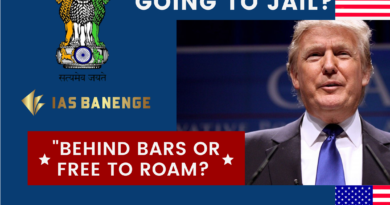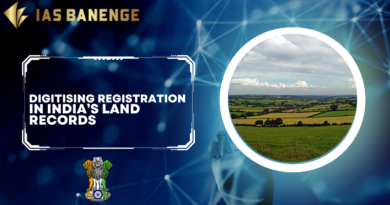Social Media’s Impact on Indian Politics |Ias Banenge
Context:
This marks the first-ever social media-driven election in India, where social media platforms have provided avenues for diverse viewpoints beyond the reach of state influence, thereby creating cognitive dissonance with the government’s narrative. Notably, it is seen that a vast majority of the public are inclined to the shows and episodes of social media influencers revolving around elections.
Relevance:
- GS2- Government Policies and Interventions
- GS3- Role of Media and Social Networking Sites in Internal Security Challenges
Mains Question:
Do you agree with the view that is the first ever social media election in India? Discuss the significance that today’s social media holds in defining the political narrative of the masses? (15 Marks, 250 Words).
READ MORE- Global Report on Internal Displacement 2024
Rise of Social Media:
A Tool Utilised by the Ruling Government:
- In recent times, social media has predominantly served as a tool utilized by the ruling government. Initially, a “right-wing ecosystem” emerged on social media to counterbalance traditional media narratives, which were perceived as less politically aligned.
- Traditional media, during the early years, refrained from active fear-mongering, leaving this role to right-wing social media platforms, which openly expressed political biases and often crossed ethical boundaries in their commentary.
- As highlighted in Kunal Purohit’s insightful book “H-Pop: The Secretive World of Hindutva Pop Stars,” this digital space serves as a means to propagate hate and incite anger against minority groups and political opponents on a daily basis, without necessarily culminating in tangible events such as hate speech rallies or riots.
Ongoing Shift:
- However, there has been a shift, particularly as traditional media outlets began echoing much of the content propagated by the right-wing ecosystem, thus saturating the information landscape.
- People are becoming increasingly aware; even staunch supporters of the ruling party acknowledge the extent of this media control.
- With a more diverse population accessing information through mobile phones and seeking alternative viewpoints, an opportunity emerged for critical voices to be heard.
- Importantly, these voices do not align themselves with any particular political party, allowing them to gain the credibility that traditional media outlets may have lost.
- Consequently, many individuals we spoke to noted that they find it easier to discern the true state of affairs in India through social media channels.
Rise of the Influencer Club on Social Media:
- Ironically, the traditional media’s shift towards more sensationalized and biased content, possibly driven by a quest for survival, might have hastened its decline.
- Influencers who offer perspectives challenging the dominant narrative have swiftly capitalized on this shift, aided by social media algorithms.
- A key aspect of algorithms used by platforms like YouTube and Facebook is that content experiencing rapid growth in popularity is given greater visibility to the entire user base.
- Social media has provided a platform for political involvement among an increasingly hesitant electorate, often silenced by a climate of fear.
- The adoption of social media has been most rapid among the educated youth demographic, once considered a stronghold of support for the ruling government.

- However, after a decade, the aspirations that once defined this demographic have largely dissipated, replaced by frustration for many.
- Educated youth, disillusioned by a lack of employment opportunities and influenced by narratives on social media, have drifted away from the BJP—and this shift is reflected in electoral outcomes.
- At its core, this represents a positive development. In a democracy, the diversity of opinions and active engagement with political views are vital.
- The opening up of these spaces indicates the emergence of sites of democratic resurgence in India.
Laws Governing Media Conduct During Elections:
During elections, media regulation primarily falls outside the purview of the Election Commission. However, the Commission is tasked with enforcing laws and court directives that may intersect with media activities.
Several laws governing media conduct during elections include:
- Section 126 of the Representation of the People Act, 1951: This section prohibits the display of any election-related content via cinematograph, television, or similar devices during the 48-hour period leading up to the conclusion of the polls.
- Section 126A of the Representation of the People Act, 1951: This section prohibits the conduct of exit polls and the dissemination of their results during specified periods, including the time leading up to the commencement of polls in the first phase and a half-hour after the close of polls for the last phase across all states and union territories.
- Section 127A of the Representation of the People Act, 1951: This section governs the printing and publication of election-related materials such as pamphlets and posters, mandating that they bear the names and addresses of the printer and publisher.
- Section 171H of the Indian Penal Code: This section prohibits the incurring of expenditures on advertisements and other activities related to elections without the authorization of the contesting candidate.
Associated Concerns:
- Social media is diminishing the relevance of party workers and intermediaries. Political narratives are now being shaped outside the confines of the formal party system.
- Traditionally, party workers and intermediaries were responsible for presenting voters with political narratives, aligning them with the ideologies of their respective parties and eliciting policy demands from grassroots levels.
- This trend facilitates greater centralization within political parties, as leaders can directly craft narratives. Additionally, algorithms contribute to increased polarization. The impact of these changes on party structures and, more significantly, the public discourse, remains uncertain.
Conclusion:
Nevertheless, the ascendancy of social media as a primary player in this election is largely due to the retreat of traditional media from its professional duty of framing political issues with credibility. What implications does this hold for reasoned discourse and the overall health of Indian democracy? This question lies at the heart of the 2024 election.




